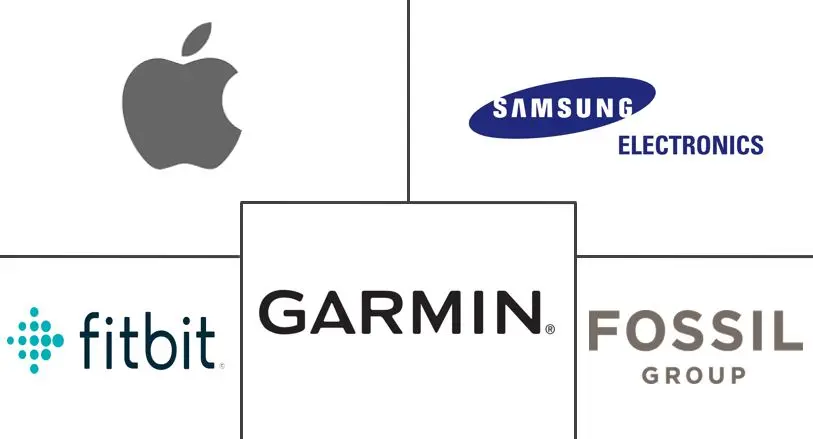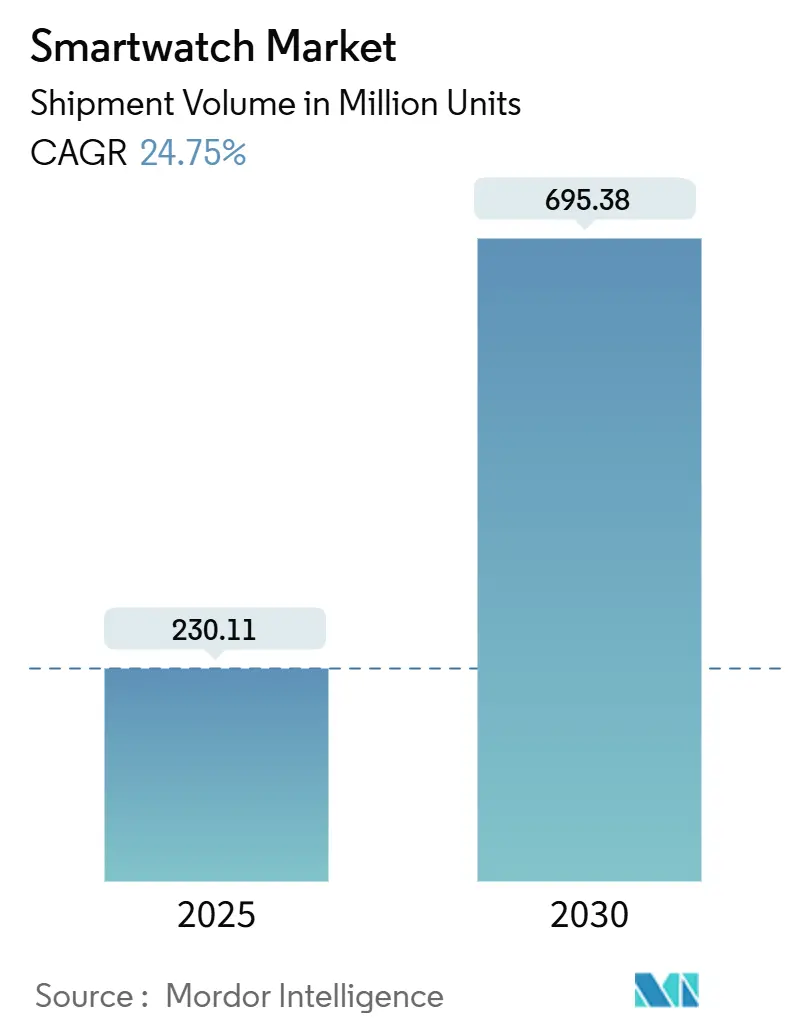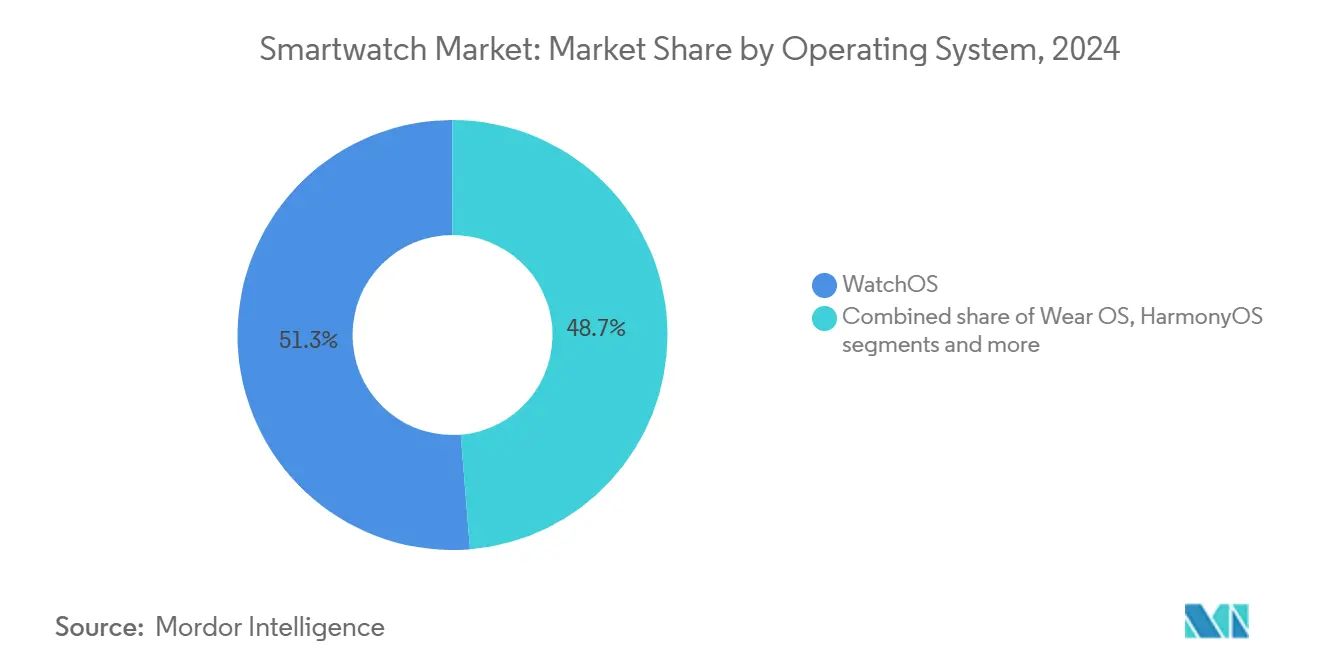Smartwatch Market Analysis by Mordor Intelligence
The smartwatch market ships 230.11 million units in 2025 and is projected to reach 695.38 million units by 2030, advancing at a 24.8% CAGR. Growth accelerates as devices evolve from lifestyle accessories toward medical-grade health monitors, a shift strengthened by Food and Drug Administration (FDA) clearances for cardiovascular notifications[1]Food and Drug Administration, “Medical Device Cardiovascular Notification Guidance,” FDA, fda.gov. AI-enabled processors now handle analytics on-device, enabling faster insights while easing privacy concerns. Corporate wellness programs that subsidize watches through insurer partnerships widen the user base, and low-power AI chips lengthen battery life to support continuous sensing. Investments exceeding USD 12 billion in Micro-LED production indicate confidence in next-generation displays, while 5G modules position premium models for stand-alone telehealth services.
Key Report Takeaways
- By operating system, WatchOS held 51.3% of the smartwatch market share in 2024; Wear OS is forecast to expand at a 25.4% CAGR through 2030.
- By display technology, AMOLED led with 56.7% revenue share in 2024, whereas Micro-LED is set to grow at a 25.9% CAGR to 2030.
- By connectivity, Bluetooth-only models commanded 60.5% of the smartwatch market size in 2024; 5G-enabled units are advancing at a 26.1% CAGR to 2030.
- By application, fitness and wellness accounted for a 49.8% share of the smartwatch market size in 2024, while medical and chronic-care use cases post a 25.1% CAGR through 2030.
- By geography, North America held 36.2% of the smartwatch market in 2024; Asia-Pacific is growing at a 25.0% CAGR to 2030.
Global Smartwatch Market Trends and Insights
Drivers Impact Analysis
| Driver | (~) % Impact on CAGR Forecast | Geographic Relevance | Impact Timeline |
|---|---|---|---|
| Rapid feature-rich upgrades by leading OEMs | +4.2% | Global, with premium focus in North America and Europe | Short term (≤ 2 years) |
| Convergence of health monitoring with telemedicine platforms | +5.8% | North America and EU leading, APAC following | Medium term (2-4 years) |
| Growing corporate wellness and insurance-linked incentive programs | +3.1% | North America dominant, expanding to APAC urban centers | Medium term (2-4 years) |
| Rising smartwatch adoption in emerging middle-income APAC cities | +4.7% | APAC core, spill-over to MEA | Long term (≥ 4 years) |
| Low-power AI chips enabling on-device analytics | +3.9% | Global, with R&D concentration in North America and East Asia | Medium term (2-4 years) |
| Government-funded remote-elder-care pilots | +2.1% | Developed markets initially, scaling to emerging economies | Long term (≥ 4 years) |
Source: Mordor Intelligence
Rapid Feature-Rich Upgrades by Leading OEMs
Apple used 3D-printed chassis parts in Series 10 to stretch screen dimensions while cutting machining steps, illustrating how agile production unlocks new features without cost inflation. Samsung’s mobile experience division posted KRW 25.8 trillion in Q4 2024, spotlighting a strategy that migrates foldable smartphone innovations into wearables. Meanwhile, Pison and STMicroelectronics will add neural sensors to Timex models in 2025, creating a premium neuro-cognitive category. Regulatory review now centers on algorithm accuracy rather than raw hardware, indicating that future differentiation will hinge on biosensing software quality.
Convergence of Health Monitoring with Telemedicine Platforms
FDA evaluations show smartwatch arrhythmia alerts prompt physician follow-up, validating the device as an entry point for telehealth services. KAIST and University of Michigan research confirms circadian-rhythm data can flag early depression risk, widening clinical value. UnitedHealth Group’s Motion program paid members USD 38 million in activity rewards, proving insurer incentives drive adoption. Because most wearable data sits outside the Health Insurance Portability and Accountability Act (HIPAA), firms that craft clear consent flows gain trust advantages[2]Department of Homeland Security, “Mobile Medical Device Cybersecurity Recommendations,” DHS, dhs.gov. These forces turn watches into healthcare nodes and create service revenue that exceeds the hardware margin.
Growing Corporate Wellness and Insurance-Linked Incentive Programs
Motion participants who met step goals reduced chronic-care costs, letting workers effectively “walk off” device payments while employers cut claims. Studies of Indian office employees show performance expectancy and habit formation drive uptake, so wellness schemes must pair financial rewards with intuitive user experiences. Linking wearable feeds to electronic health records personalizes coaching, yet only 30% of consumers will share data without proof of strong privacy protection, signaling that transparent governance is essential.
Rising Smartwatch Adoption in Emerging Middle-Income APAC Cities
Penetration gaps between South Korea’s 6.6% and Indonesia’s 2% highlight a sizable runway as social image factors blend with falling average selling prices. Garmin’s expanded Malaysia and Taiwan plants shorten supply lines and cater to local tastes, confirming the region’s role as both factory and fast-growth consumer hub. Marketing strategies that mix fashion aesthetics with health analytics resonate with urban Gen Z buyers who treat wearables as status devices.
Restraints Impact Analysis
| Restraint | (~) % Impact on CAGR Forecast | Geographic Relevance | Impact Timeline |
|---|---|---|---|
| Data-privacy regulations tightening health-data flows | -3.4% | EU leading, North America following, APAC varying by country | Medium term (2-4 years) |
| Battery-life limitations due to continuous sensing | -2.8% | Global, with premium segment impact in developed markets | Short term (≤ 2 years) |
| Supply-chain fragility for advanced OLED panels | -2.1% | Global, concentrated in East Asian manufacturing hubs | Short term (≤ 2 years) |
| Plateauing differentiation in mid-tier price band | -1.9% | Global, with particular impact in emerging markets | Medium term (2-4 years) |
Source: Mordor Intelligence
Data-Privacy Regulations Tightening Health-Data Flows
The European Union’s Digital Markets Act compels Apple to open iOS interfaces to third-party watches, shifting data control back to consumers and raising compliance costs. Academic reviews note that, because HIPAA excludes most wearable data, pending laws may impose notification mandates when information is sold. Transparency around opt-in settings strengthens brand loyalty but may slow feature launches while firms re-architect data pipelines.
Battery-Life Limitations Due to Continuous Sensing
SmartAPM energy-management algorithms improve run time, yet growing sensor counts raise baseline demand. Prototype aqueous batteries promise higher density, but commercial roll-outs remain two to three years away. For mid-tier devices, OEMs may trim always-on functions to preserve one-day endurance, a compromise that can blunt differentiation in price-sensitive segments.
Segment Analysis
By Operating System: Wear OS Shrinks the WatchOS Gap
WatchOS retained 51.3% smartwatch market share in 2024 through tight vertical integration and FDA-approved heart metrics. Wear OS, supported by Google’s collaborations with Masimo and Qualcomm, is forecast to post a 25.4% CAGR and pull smaller brands into a shared ecosystem.
Broader adoption of reference platforms reduces development costs, allowing niche labels to skip custom firmware and focus on services. HarmonyOS gains home-market momentum in China, while real-time operating systems power rugged industrial models. Future advantage will rest on cloud APIs and subscription analytics rather than proprietary kernels, a shift that flattens the competitive hierarchy and enlarges the overall smartwatch market.
Note: Segment shares of all individual segments available upon report purchase
By Display Technology: Micro-LED Edges Toward Scale
AMOLED accounted for 56.7% of revenue in 2024, underpinned by mature supply chains in South Korea and China. Micro-LED shipments are forecast to grow at a 25.9% CAGR, supported by Osram’s USD 1 billion Malaysia facility and other USD 12 billion global investments.
Manufacturers pursue mass-transfer breakthroughs to align microscopic emitters at high yield, aiming for superior brightness and power savings. Early Micro-LED units debut in luxury price tiers, giving brands a halo effect while amortizing capital outlays. The smartwatch market size for Micro-LED models could expand markedly once economies of scale close the cost gap with AMOLED panels.
By Connectivity: 5G Becomes the Premium Badge
Bluetooth-only designs held 60.5% of shipments in 2024, favored for long battery life and low bill-of-materials cost. Units fitted with 5G radios are set to rise at a 26.1% CAGR as consumers demand untethered calling and real-time clinical uploads.
Standalone cellular capability allows remote patient monitoring even when a phone is absent, a feature prized in elder-care and high-risk worker programs. The smartwatch market size for 5G SKUs gains from edge-offload models that cut latency for AI tasks. Battery performance and antenna miniaturization remain bottlenecks, but chipset roadmaps suggest further integration will ease design trade-offs by 2027.
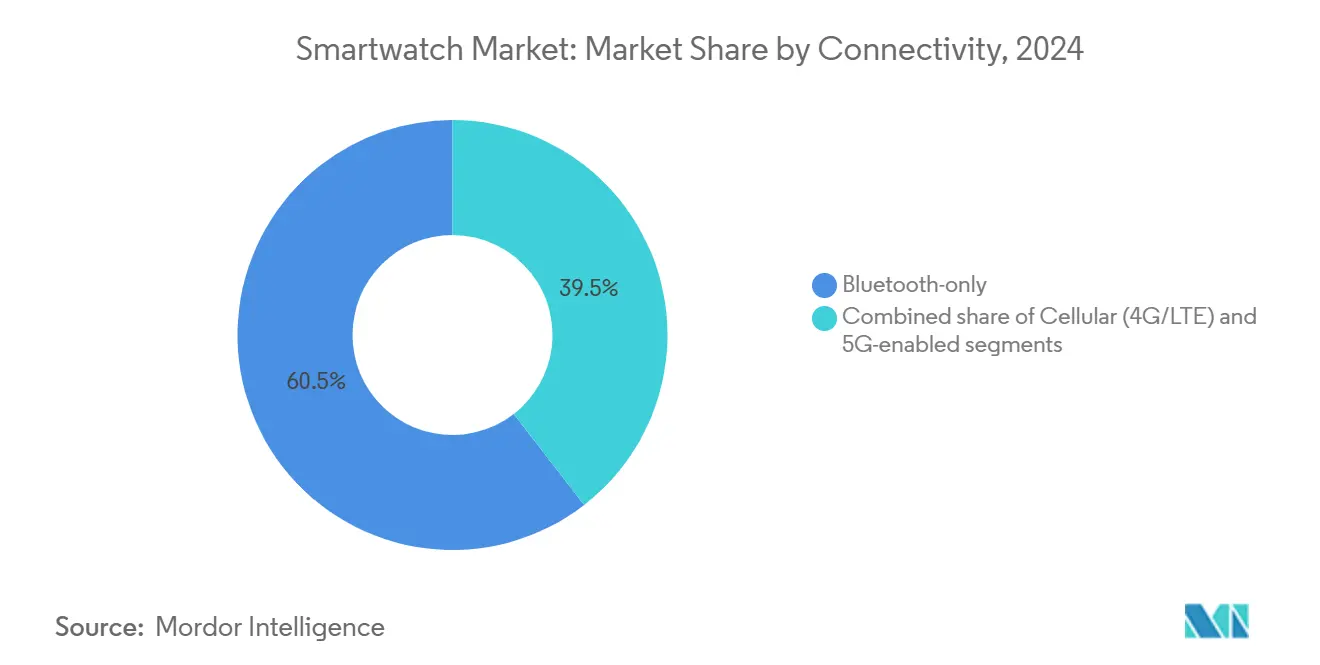
Note: Segment shares of all individual segments available upon report purchase
By Application: Medical Use Cases Accelerate
Fitness and wellness still account for 49.8% of 2024 shipments, yet medical and chronic-care applications are set to register a 25.1% CAGR after FDA validations. Corporate insurers fund devices for diabetes and hypertension cohorts, gradually shifting unit mix toward clinical functions.
Tele-psychiatry gains traction after KAIST studies proved depression markers are detectable in circadian data. The smartwatch market size for medical models is likely to expand further as neural sensors enter mainstream catalogs. Privacy assurances will be critical because only transparent data policies will unlock patient consent for high-frequency monitoring.
Geography Analysis
North America’s 36.2% share reflects early medical clearances, robust employer incentives, and strong replacement cycles. UnitedHealth Group’s reward program has shown that claims savings can offset device subsidies within a year. Patent disputes briefly removed blood-oxygen features from new Apple models, but rapid firmware workarounds preserved demand. Regional supply-chain risk surfaced when quartz shortages delayed semiconductor etching, prompting diversification to alternative mineral sources.
Europe benefits from a single digital market framework that balances openness and privacy. The Digital Markets Act loosens platform lock-in, boosting smaller brands that rely on iPhone compatibility[3]European Commission, “Digital Markets Act Implementation,” European Union, ec.europa.eu. Consumer advocacy for data sovereignty shapes product design choices, with opt-in telemetry dashboards now standard on most launches. Compliance burdens may be consolidated among firms that maintain dedicated privacy engineering teams.
Asia-Pacific posts a 25.0% CAGR on the back of emerging-market momentum. Social influence and falling price points drive first-time adoption in Indonesia, Vietnam, and India, while South Korea and Japan sustain premium upgrade cycles. Regional production clusters in Malaysia and Taiwan lower logistics costs and speed localization, positioning vendors for rapid reaction to fashion trends. Government elder-care pilots in China and Singapore further support clinical roll-outs, reinforcing the region’s status as both demand engine and supply base for the global smartwatch market.
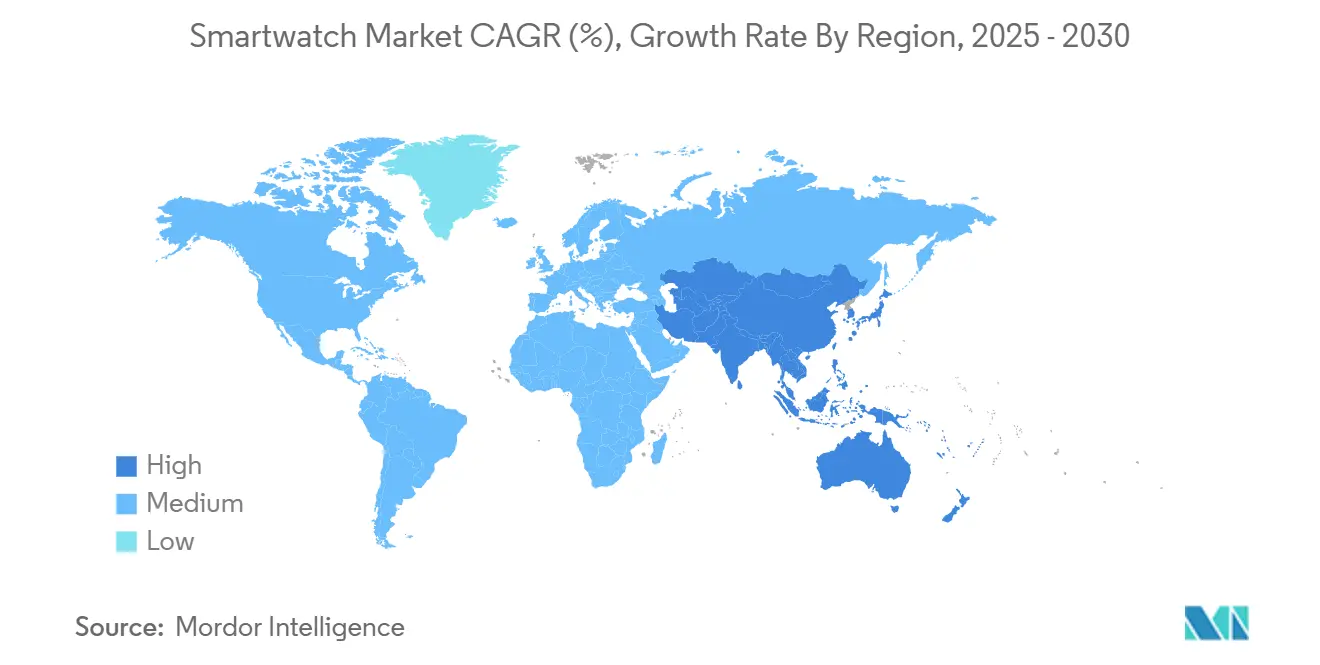
Competitive Landscape
Apple, Samsung, and Google-aligned partners take a majority of shipments, placing the sector in a moderately concentrated state. Apple’s ecosystem and WatchOS advantages are counterbalanced by regulatory requirements for interoperability and by Masimo’s sensor patents, which showcased how a specialized health-tech firm can influence top-tier product roadmaps. Samsung extends smartphone AI frameworks to wearables, while Google’s reference platforms compress time-to-market for second-tier labels.
Niche opportunities arise in neuro-cognitive sensing, where Pison’s ENG chip promises gesture control and mental-state tracking. Battery breakthroughs and on-device AI architectures form another battleground, with suppliers racing to secure design wins for sub-5 nm chipsets. Supply-chain resilience now shapes competitive narratives; brands that diversify critical mineral inputs and panel sources stand to capture share when isolated disruptions strike.
Future rivalry will focus less on raw hardware and more on health-data services, predictive algorithms, and multi-device bundles that mix watches, earbuds, and rings. As subscription analytics grow, the smartwatch market will reward firms that maintain clinician partnerships and secure reimbursable certifications.
Smartwatch Industry Leaders
-
Apple Inc.
-
Samsung Electronics Co. Ltd
-
Garmin Ltd
-
Fitbit Inc.
-
Fossil Group Inc.
- *Disclaimer: Major Players sorted in no particular order
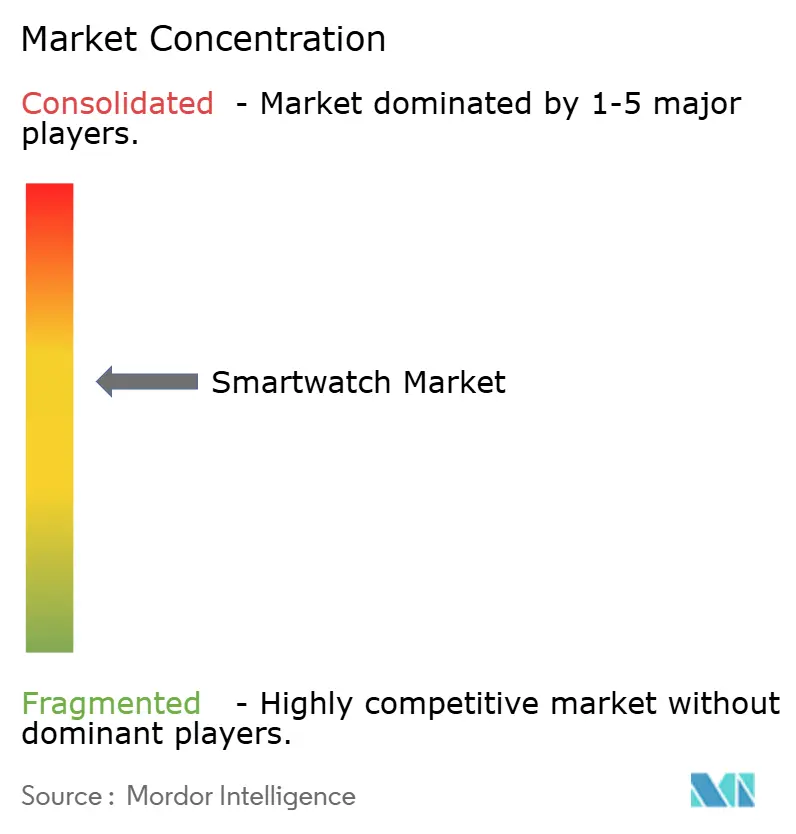
Recent Industry Developments
- May 2025: Apple reported USD 7.5 billion in Q2 wearables revenue and confirmed broader production shifts to India and Vietnam.
- March 2025: European Commission ordered Apple to open iOS interfaces for third-party smartwatches, targeting full compliance by 2026.
- January 2025: Pison and STMicroelectronics partnered with Timex to commercialize neural-sensor watches launching in spring 2025.
- January 2025: KAIST and University of Michigan published a study demonstrating depression prediction from smartwatch circadian data.
Global Smartwatch Market Report Scope
A smartwatch is a portable gadget worn on the wrist that supports apps and, in certain situations, works as an extension of the cell phone. Depending on the manufacturer and model, they offer a variety of functions that can have a significant impact on day-to-day life. Many people use smartwatches to keep track of their health or manage emails, texts, and phone conversations without carrying their phones. The market studied is segmented by operating system (watch OS, wear OS and other operating systems), display type (AMOLED, PMOLED, TFT LCD), application (personal assistance, medical, sports, and other applications), and geography (North America, Europe, Asia-Pacific, and Rest of the World). The market sizes and forecasts are provided in terms of value USD for all the above segments.
| By Operating System | WatchOS | |||
| Wear OS | ||||
| HarmonyOS | ||||
| Proprietary / RTOS | ||||
| By Display Technology | AMOLED | |||
| Micro-LED | ||||
| TFT-LCD | ||||
| By Connectivity | Bluetooth-only | |||
| Cellular (4G/LTE) | ||||
| 5G-enabled | ||||
| By Application | Fitness and Wellness | |||
| Medical and Chronic-care | ||||
| Personal Assistance and Payments | ||||
| Other Applications | ||||
| By Geography | North America | United States | ||
| Canada | ||||
| Mexico | ||||
| Europe | Germany | |||
| United Kingdom | ||||
| France | ||||
| Italy | ||||
| Spain | ||||
| Rest of Europe | ||||
| Asia-Pacific | China | |||
| Japan | ||||
| India | ||||
| South Korea | ||||
| Australia and New Zealand | ||||
| Rest of Asia-Pacific | ||||
| South America | Brazil | |||
| Argentina | ||||
| Rest of South America | ||||
| Middle East and Africa | Middle East | Saudi Arabia | ||
| United Arab Emirates | ||||
| Turkey | ||||
| Rest of Middle East | ||||
| Africa | South Africa | |||
| Egypt | ||||
| Nigeria | ||||
| Rest of Africa | ||||
| WatchOS |
| Wear OS |
| HarmonyOS |
| Proprietary / RTOS |
| AMOLED |
| Micro-LED |
| TFT-LCD |
| Bluetooth-only |
| Cellular (4G/LTE) |
| 5G-enabled |
| Fitness and Wellness |
| Medical and Chronic-care |
| Personal Assistance and Payments |
| Other Applications |
| North America | United States | ||
| Canada | |||
| Mexico | |||
| Europe | Germany | ||
| United Kingdom | |||
| France | |||
| Italy | |||
| Spain | |||
| Rest of Europe | |||
| Asia-Pacific | China | ||
| Japan | |||
| India | |||
| South Korea | |||
| Australia and New Zealand | |||
| Rest of Asia-Pacific | |||
| South America | Brazil | ||
| Argentina | |||
| Rest of South America | |||
| Middle East and Africa | Middle East | Saudi Arabia | |
| United Arab Emirates | |||
| Turkey | |||
| Rest of Middle East | |||
| Africa | South Africa | ||
| Egypt | |||
| Nigeria | |||
| Rest of Africa | |||
Key Questions Answered in the Report
What is the current size of the smartwatch market in 2025?
Global shipments reach 230.11 million units in 2025, reflecting strong demand for health-focused wearables.
How fast is the smartwatch market expected to grow?
Shipments are forecast to rise at a 24.8% CAGR, reaching 695.38 million units by 2030.
Which operating system is gaining share the quickest?
Wear OS is projected to expand at a 25.4% CAGR through 2030, benefiting from Google’s partnerships with Masimo and Qualcomm.
What segment is driving future unit growth?
Medical and chronic-care applications are advancing at a 25.1% CAGR as FDA-cleared cardiovascular and mental-health features gain traction.
Which region will post the fastest growth through 2030?
Asia-Pacific is set to lead with a 25.0% CAGR, driven by middle-income adoption and government elder-care initiatives.
What is the biggest technical hurdle for smartwatch makers today?
Battery life remains the key constraint, even with algorithms such as SmartAPM boosting endurance by 36%.
Page last updated on: June 19, 2025
